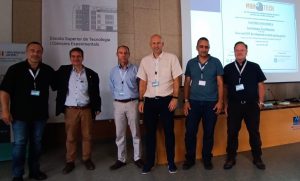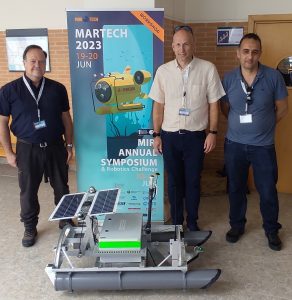Home » meetings
Category Archives: meetings
Best article in the field of marine technology and renewable energy in the Martech workshop


Award for the best article in the field of marine technology and renewable energy sponsored by Nautilus Oceanica at the Martech 2023 congress, Tenth international workshop on marine technology, Jaume I University, Castellón de la Plana. For the article entitled: “Low cost USV development to study spring ponds” by Ronda, J. L., Benabdeloued, B. Y. N. and Tent-Manclús, J. E. belonging to the Department of Earth and Environmental Sciences and the Seismic Network of the Valencian Community (SISCOVA).

The article deals with the development of a USV (Unmanned Surface Vehicle) a surface unmanned ship for the study of springs. It is a small remote-controlled vehicle with a control post, from where it is manned. It has two cameras, one underwater and one frontal, which transmit real-time GPS location, also in real time, and bathymetry probe sensors and side-scan Sonar.

The authors with the USV team.


Villafranqueza corals in the 34th IAS Meeting of Sedimentology (Rome)
Entobia is a well-known ichnofacies typical for nearshore environments, differentiated from the Gnatichnus ichnofacies as being related to more stable conditions in high-energy settings and longer times of exposure of the bottoms. Surroundings of the city of Alicante (Villafranqueza section, SE Spain), boring structures related to the Entobia ichnofacies were observed on an Eocene rockground colonized after a Miocene marine ingression. Reefrelated facies are present as coral colonies developed after the transgression and show evidence of bioerosive activity. The relationship existing between the growing coral colony and boring organisms is addressed in order to elucidate ecological interactions and palaeoenvironmental conditions. The studied section is characterized by a very evident angular unconformity dividing the underlying Eocene sandy turbiditic beds from the overlying Miocene coastal limestones. The Entobia ichnofacies is developed on a variety of substrates, represented by the Eocene rockground, resedimented lithoclasts, different bioclasts (mainly thick shelled bivalves and gastropods) and coral bioconstructions. Boring structures are mainly represented by Gastrochaenolites, Entobia (usually preserved as internal mould) and, more rarely, Trypanites. Differences in the relative abundance of the three ichnotaxa were observed according to the substrate: i) on the rockground, Gastrochaenolites and Trypanites are the most abundant ichnotaxa, being Gastrochaenolites represented by different ichnospecies; ii) the three ichnotaxa are present in litho- and bio-clasts; iii) in corals, almost exclusively Gastrochaenolites torpedo is found. On the rockground, deep penetrating borings as Gastrochaenolites are differently preserved, being present complete forms together with partially eroded ones on the same surface. This would suggest that colonization occurred over long times, due to prolonged exposure of the bottoms. Together with possible ecological restrictions, a preservation bias induced by such a prolonged exposure must be considered in order to justify the relative abundance of the deep structures typical for the Entobia ichnofacies with respect to the shallow-tiered ones. Where Gastrochaenolites is associated to corals, bivalves were found inside the bioerosion structures being mainly represented by Lithophaga sp.. In this sense, a bioerosive activity specialism is detected, since Gastrochaenolites is extremely more abundant in the bioconstructions produced by the coral Tarbellastrea than in those where other types of corals are present (e.g. Porites and Siderastraea), thus suggesting some kind of ecological interplay. Moreover, the study of the geometrical and morphological relationship between Tarbellastrea and Gastrochaenolites shows that, in part of the observed specimens, the coral was growing all around the lithophagid borehole. This would suggest that corals and bivalves developed at the same time and that the shelly colonization and the progress of the host patch reef did not occur in different successive phases.
Cite as: Giannetti, A., Falces-Delgado, S., and Baeza-Carratalá, J. F. (2019): Interaction of boring organisms with corals. Entobia ichnofacies development in a transgressive nearshore scenario. 34th IAS International Meeting of Sedimentology, Rome 10-13 September 2019. “Sedimentology to face societal challenges on risk, resources and record of the past. Sesion 8.A-660.

The Villafranqueza unconformity in the logo of the Alicante University Departament of Earth Science and Environment.
Kuphus beds at the 34th IAS Meeting of Sedimentology
“Kuphus beds in an Oligocene carbonate platform (Sierra de la Argüeña, Southeastern Spain): palaeoecological context and relationship with shallowing-upward cycles” by Alice Giannetti and Santiago Falces-Delgado
Although the Oligocene carbonate platforms saw the development of Kuphus-dominated assemblages, few studies addressed the role of these bivalves in ancient shallow-water ecosystems. Kuphus is a genus of peculiar teredinid burrower bivalves that begun to be common in the Oligocene, reaching their maximum abundance in the Oligocene-Aquitanian time interval. Nowadays, they are represented only by the species K. polythalamia, present in the Western Pacific. Recent studies revealed that the physiology of K. polythalamiais based on symbiosis with chemoautotroph sulphur bacteria, this producing new interest about the role of Kuphus in ancient carbonate platforms. Kuphus siphons are embedded in concentric calcitic sheets forming long subcylindrical tubes, which accumulation produces thick beds with good preservation potential. In the Sierra de la Argüeña (Alicante province, Southeastern Spain), different types of Kuphus beds were recovered in nearshore carbonate platform deposits, preserved either as resedimented material or in situ assemblages. Five facies were distinguished: i. marly limestones rich in fragments of Kuphus tubes, corals, irregular echinoids, bivalves and gastropods; ii. miliolid-rich wackestones/packstones with small turriculate gastropods and the branched coral Stylophora, representing protected environments close to the coast; iii. small coral bioconstructions formed by laminar and domed colonies of Porites, Montipora, Actinastrea and different favids; iv. packstones rich in red algae and echinoid fragments with lepidocyclinids and miliolids, filling the space between coral bioconstructions; v. fine-grained greenish silty sands, locally associated to Microcodium. These facies are repeated throughout the section to form regressive cycles from the lagoon to coral patch reefs developed in the inner platform and then to nearshore areas, in proximity of the emerged coast. Beds with resedimented Kuphus tubes are found in the lowermost or in the uppermost part of the regressive sequences; in both situations, preferred orientation is absent. In the first case, they are made up of tube fragments mixed with other bioclasts and have been interpreted as perireefal accumulations. In the second case, the beds are made up almost exclusively of Kuphus tubes, show quite a high density of tube fragments and wide areal development. These have been interpreted as product of physical reworking, e.g. by storms. Several patches of tubes in life position vertically cross this bioclastic rudstones, suggesting that some bivalves survived the event and resumed the construction of the tube after the storm ceased. At the very top of the section, anterior ends are preserved in life position inside the fine-grained silty sands of facies v. This last level is of particular interest, since it represents the original undisturbed environment of the pioneer colonies. So far, accumulation of organic matter and plant remains similar to those present in the habitat of modern-day Kuphus were not observed in this bed, this suggesting the possibility that Oligocene Kuphus could have retained normal filter feeding mechanisms and were not obligate chemotrophic organisms. This would recommend prudence with the use of modern-day Kuphus polythalamia as an ecological analogue of fossil Kuphus and that further study is needed before considering the latter a proxy for poorly oxygenated environments.

Cite as: Giannetti, A., and Falces-Delgado, S. (2019): Interaction of boring organisms with corals. Entobia ichnofacies development in a transgressive nearshore scenario. 34th IAS International Meeting of Sedimentology, Rome 10-13 September 2019. “Sedimentology to face societal challenges on risk, resources and record of the past. Sesion 1.A-989.

Recent Comments